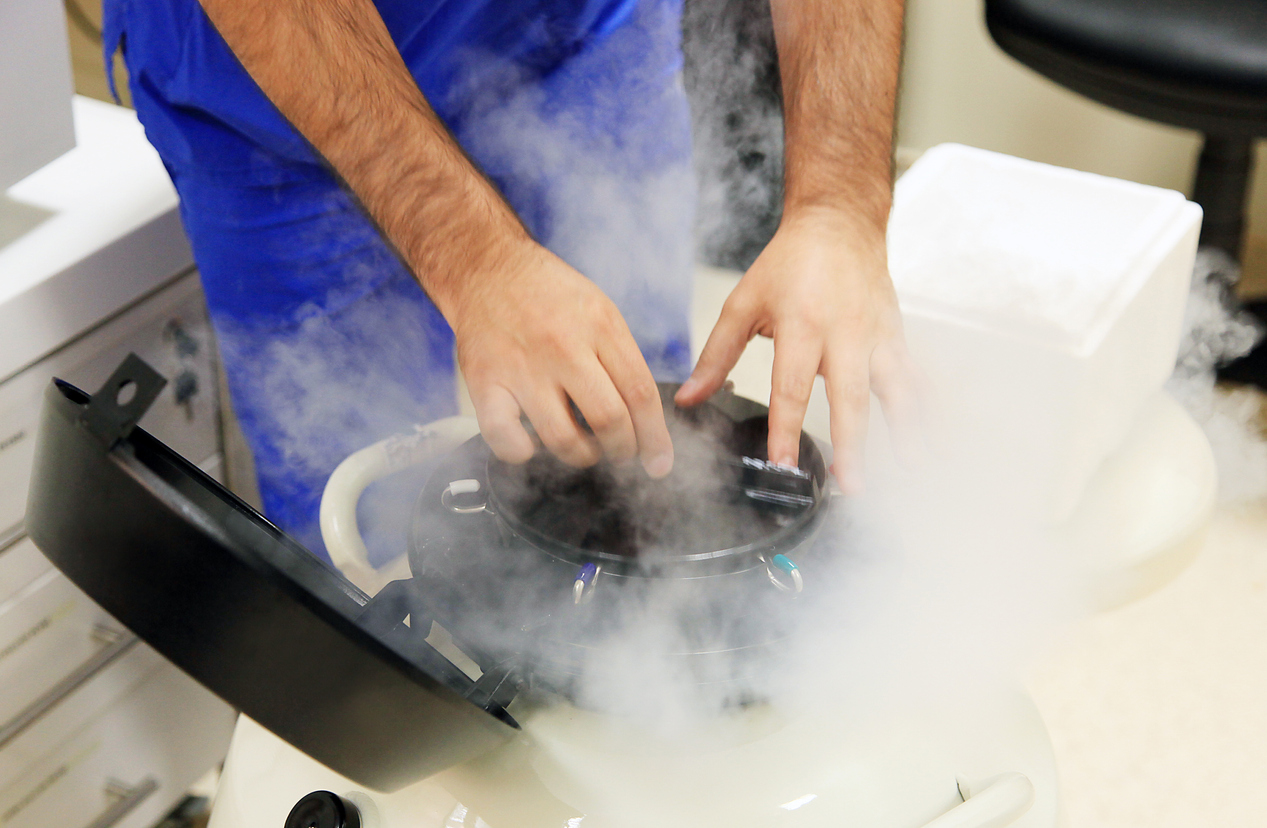The Guide to Egg Freezing Costs in the US

Oocyte Cryopreservation, also known as egg freezing, is a technology that allows prospective parents to preserve their eggs for later use. Egg-freezing costs can be high, though, so it’s important to be aware of how the costs work prior to beginning the process of egg-freezing.
We’ll take you through the procedures and costs, step by step, to help you make the best decision for you and your future family.
Why Egg Freezing?
The primary reason people freeze their eggs is for fertility preservation.
The ovarian reserve (number of eggs in the ovaries) is at its highest before age 35. Eggs produced before this age also have a better chance of producing healthy embryos than mature eggs. And frozen eggs can be kept for up to 55 years.
Someone who knows they want to be a parent, but are not in the right circumstances to do it immediately, may want to save healthy eggs for later.
A person undergoing fertility-damaging medical procedures may also want to preserve their eggs for after the treatment is finished.
People undergoing infertility treatments, such as in-vitro fertilization (IVF treatment), may also freeze their eggs for subsequent rounds of treatment.
How Much Does Egg Freezing Cost?

Image source: Getty Images
The total cost for a single cycle of retrieval and freezing can reach $10,000 to $20,000 in the USA. Most people undergo 2.1 cycles. After that, storage of frozen eggs or embryos can cost between $500 and $1200 per year.
Costs can vary according to your location, the procedures and medications involved, and individual fertility clinics themselves. Egg freezing is often considered elective. Therefore some healthcare or health insurance plans may not cover it.
Your fertility center may offer finance or payment plans. But if you do take on financing, you will have to pay that money back, with interest.
What will you be paying for, exactly? Here’s a general layout of the egg-freezing cycle.
Exams and Consultation
Treatment always starts with a consultation and a medical exam.
First, you’ll meet with a fertility specialist to discuss fertility testing, egg freezing, and other fertility treatments, and to figure out if egg freezing is right for you.
After that, there will be a medical exam that will include a complete medical history, hormone testing, and blood work. You may also be examined through a transvaginal ultrasound. This is a generally painless procedure that healthcare professionals use to investigate and diagnose many different gynecological conditions. In this instance, it will be used to assess the number of eggs in your ovaries.
With this information, your doctor will be able to estimate the number of eggs they will be able to retrieve, and come up with a medication protocol for stimulating egg production.
The cost for consultations and exams can vary from doctor to doctor, but the average sits around $300 - $1,000 per consultation, with additional costs for exams and lab work.
Ovarian Stimulation and Monitoring
Stimulating the ovaries to produce eggs is a way to ensure that your doctor can safely harvest the largest possible number of eggs. This is done with fertility medications.
The medication protocol for ovarian stimulation varies from individual to individual.
Depending on where you are in your ovulation cycle, your doctor may prescribe birth control pills, estrogen, lupron, or Aygestin to synchronize your follicles prior to treatment. This will help to ensure that your injections begin at the right time.
Once the time is right, you’ll begin injections of gonadotropins. These include FSH, (follicle-stimulating hormone), and LH, (luteinizing hormone). You will inject this medication yourself, generally subcutaneously in the belly, for 10 to 12 consecutive days.
You will have regular checkups during this time to monitor the effectiveness of the medications. Your doctor may also advise against strenuous activity.
The cost of ovarian stimulation medications can range between $2,000 and $7,000. Checkups and monitoring may incur additional costs.
Egg Retrieval
Egg harvesting, or retrieval, involves removing the eggs from your ovaries. This is done under general anesthesia and takes between 10 and 20 minutes to complete.
Retrieval involves using a needle to remove the fluid inside the follicles that contain the eggs. An embryologist will then examine the fluid to find out how many eggs have been retrieved.
Some individuals may require more than one retrieval.
The cost of the egg retrieval procedure can range from $600 to $1,500. This fee is often included in the base fee which can range from $12,000 to $14,000.
Egg Freezing and Storage
Recovered oocytes are frozen using a rapid freezing process using liquid nitrogen. This process is called vitrification.
Depending on the facility, freezing and storage fees can cost between $500 and $1,200 per year of storage.
Additional Costs
Using your eggs later will incur additional costs. Some of these costs may include thawing, embryo transfer, implantation, and others.
Insurance and Egg Freezing Costs

Some states require insurance plans to cover certain reproductive medicine treatments.
According to the National Fertility Association, twenty states have infertility insurance laws.
In addition, Connecticut, Delaware, Maryland, New Hampshire, New Jersey, New York, and Rhode Island have fertility preservation laws.
Individual laws and requirements vary from state to state, so it’s important to check your own state’s laws for specifics.
State By State Laws for Fertility Treatments
Does your state require insurance to cover fertility treatments? If your state is on this list, make sure you know the details of who, how, and how much.
Arkansas
Individual and group insurance policies that provide maternity benefits must cover IVF. This excludes HMOs. There is a lifetime cap of $15,000. Other infertility treatments are included, as is cryopreservation.
The patient and spouse must have a two-year history of infertility. The patient must be the policyholder or the spouse of the policyholder, and the patient’s eggs must be fertilized with the spouse’s sperm.
Note: the language of the law specifies that the patient and spouse must be a married male-female couple.
Employers who self-insure are exempt.
California
Insurers are not required to offer fertility treatment coverage unless employers who offer their insurance choose to provide it. Religious organizations and employers who self-insure are exempt.
When a covered treatment may cause iatrogenic infertility (infertility caused by medical treatment, such as cancer treatment) in an enrolled patient, standard fertility preservation services must be provided.
The patient’s infertility must have lasted a minimum of a year, if not caused by medical treatment.
IVF does not have to be covered.
Colorado
As of January 1, 2023, employer-provided health benefit plans covering more than 100 people are required to provide coverage for infertility diagnosis and treatment, including:
- Three egg retrieval cycles
- Unlimited embryo transfers
- Fertility medications
In addition, the insurer may not impose deductibles, copayments, coinsurance, benefit maximums, waiting periods, or other limitations that are different from those imposed on covered services not related to fertility.
Religious organizations, individual and small group policies, and employers that self-insure are exempt.
Patients’ infertility must have lasted a minimum of 12 months for women under 35 or six months for women aged 35 or older. Miscarriage after treatment does not restart the clock.
Connecticut
State law requires that insurance cover a lifetime maximum of:
- Four cycles of ovulation induction
- Three cycles of intrauterine insemination
- Two cycles of IVF, GIFT, ZIFT, or lower tubal ovum transfer with no more than two embryo implantations per cycle.
Patients must have maintained insurance coverage for at least 12 months. Infertility must have lasted a minimum of one year if it is not iatrogenic.
Religious organizations and employers who self-insure are exempt.
Delaware
All individual, group, and blanket health insurance policies that provide medical or hospital expenses must include coverage for fertility care services. These include:
- Standard fertility preservation before treatment that may cause iatrogenic infertility
- Intrauterine insemination
- Assisted hatching
- Cryopreservation and thawing of eggs, sperm, and embryos
- Cryopreservation of ovarian tissue
- Cryopreservation of testicular tissue
- Embryo biopsy
- Consultation and diagnostic testing
- Fresh and frozen embryo transfers
- Six completed egg retrievals per lifetime, with unlimited embryo transfers
- IVF, including IVF using donor eggs, sperm, or embryos, and IVF where the embryo is transferred to a gestational carrier or surrogate
- Intracytoplasmic sperm injection (“ICSI”)
- Medications
- Ovulation induction
- Storage of oocytes, sperm, embryos, and tissue
- Surgery, including microsurgical sperm aspiration
- Medical and laboratory services that reduce excess embryo creation.
Policies may not impose restrictions, deductibles, copayments, coinsurance, benefit maximums, waiting periods, or any other limitations on fertility coverage that are different from those imposed upon benefits for services not related to infertility.
Religious organizations, self-insuring employers, and employers with fewer than 50 employees are exempt.
Hawaii
Individual and group insurers are required to cover one cycle of IVF, provided the patient has a five-year history of infertility or the infertility is associated with endometriosis; DES exposure; blocked or surgically removed fallopian tubes; or abnormal male factors.
Patients must have tried other covered fertility treatments first.
Self-insuring employers are exempt.
Illinois
For women aged 35 and under who have suffered infertility for a minimum of 12 months, or women aged over 35 who have suffered infertility for over six months, or for women suffering iatrogenic infertility, group insurers and HMOs that provide pregnancy-related coverage must also provide
- Infertility diagnosis
- IVF
- Uterine embryo lavage
- Embryo transfer
- Artificial insemination
- GIFT
- ZIFT
- Low tubal ovum transfer
- Up to four egg retrievals, plus two more if a live birth occurs, for a lifetime maximum of six
- Standard fertility preservation in the case of treatments that may cause iatrogenic infertility.
In addition, a policy may not impose exclusions, limitations, or restrictions on coverage of fertility medications, infertility diagnosis or treatments, or standard fertility preservation services.
Employers with fewer than 25 employees and religious employers are exempt.
Louisiana
State law prohibits insurers from excluding coverage for the diagnosis and treatment of a correctable medical condition solely because the condition results in infertility.
Self-insuring employers are exempt.
Maine
Insurance carriers must provide coverage for:
- Fertility diagnostic care
- Fertility treatment
- Fertility preservation services
Patients must demonstrate infertility lasting a minimum of 12 months, or have a medical condition that could impair their fertility.
Experimental procedures and non-medical costs do not need to be covered.
Maryland
Individual and group insurance policies that provide pregnancy-related benefits must cover three IVF cycles per live birth, with a lifetime maximum of $100,000.
Married patients must demonstrate one year of involuntary infertility. Unmarried patients must demonstrate three unsuccessful courses of artificial insemination over the course of one year or iatrogenic infertility.
The patient must be the policyholder or a covered dependent of the policyholder and must have attempted to obtain a successful pregnancy through less costly infertility treatments.
Religious employers, employers with fewer than 50 employees, and self-insuring employers do not have to provide coverage. Egg storage is not covered.
Massachusetts
Insurers providing pregnancy-related benefits must also provide coverage for:
- Infertility diagnosis
- Artificial insemination
- IVF
- GIFT
- Sperm, egg, and/or inseminated egg procurement and processing
- Sperm banking
- Inseminated egg banking
- ICSI
- ZIFT
- Assisted hatching
- Cryopreservation.
The law doesn’t limit the number of treatment cycles, and there is no lifetime cap, though insurers may set limits based on their clinical guidelines and patients’ medical histories.
Patients must demonstrate one year of infertility for female patients 35 or younger, or six months for female patients over the age of 35.
Insurers are not required to cover:
- Experimental procedures
- Reversal of voluntary sterilization
- Surrogacy
Employers who self-insure are exempt.
Montana
State law requires HMOs to cover infertility services but does not define infertility.
Self-insuring employers are exempt.
New Hampshire
Health carriers that issue group plans must provide coverage for:
- Infertility diagnosis
- Medically necessary fertility treatment
- Fertility preservation for people undergoing medical treatment that may cause infertility.
Insurers may not impose restrictions, waiting periods, or other limitations that are different from those imposed for non-fertility-related treatments. Insurers may not impose pre-existing condition exclusions on infertility treatments.
Coverage does not apply to plans available through the Small Business Health Options Program (SHOP) or to Extended Transition to Affordable Care Act-Compliant Policies. Experimental procedures do not have to be covered.
New Jersey
Group insurers, HMOs, State Health Benefits Programs, and School Employees' Health Benefits Programs that provide pregnancy-related coverage must provide infertility treatment including
- Artificial insemination
- Assisted hatching
- Diagnosis and diagnostic testing
- Fresh and frozen embryo transfers
- Four completed egg retrievals per lifetime
- IVF
- ICSI
- GIFT
- ZIFT
- Fertility medications
- Ovulation induction; and
- Surgery
- Standard fertility preservation services when a medically necessary treatment may directly or indirectly cause iatrogenic infertility.
Infertility is defined as 12 months of failed conception or 12 failed attempts at artificial insemination for women aged 35 or younger, or six months of the same for women aged 35 to 46. The definition also includes the inability to bring a pregnancy to live birth.
Insurers do not have to cover:
- Cryopreservation except for those at risk of iatrogenic infertility
- Non-medical costs of egg and sperm donors
- Storage of harvested eggs or sperm
Employers with fewer than 50 employees, self-insuring employers, and religious employers are exempt.
New York
Group policies are required to provide:
- hysterosalpingogram
- hysteroscopy
- endometrial biopsy
- laparoscopy
- sonohysterogram
- post-coital tests
- testis biopsy
- semen analysis
- blood tests
- ultrasound
- Up to three IVF cycles
- Fertility preservation for iatrogenic infertility
- Fertility medications
Patients aged 35 and younger not anticipating iatrogenic infertility must demonstrate 12 months of infertility. For patients aged over 35, the requirement is six months.
Individual and small group markets are not required to cover IVF, GIFT, ZIFT, reversal of elective sterilizations, sex change procedures, cloning, or experimental medical or surgical procedures.
Employers who self-insure are exempt.
Ohio
HMOs are required to cover medically necessary infertility services, diagnostic and exploratory procedures, and corrective surgical procedures. IVF, ZIFT, and GIFT may be covered but coverage is not required by law.
Self-insuring employers are exempt.
Rhode Island
Insurers and HMOs that cover pregnancy benefits must provide coverage for medically necessary diagnosis and fertility treatments for women aged 25 to 42. Fertility preservation does not have to be covered, except in the case of iatrogenic infertility.
There is a lifetime cap of $100,000.
Self-insuring employers are exempt.
Texas
State law does not require coverage, though group insurers are required to offer IVF. Employers may decide if they want to include infertility coverage with their employee health benefits packages.
If they do offer this coverage:
- IVF patients must be the policyholder or the spouse of the policyholder
- Eggs must be fertilized with the patient’s spouse's sperm
- Patients must have a history of five continuous years of infertility OR iatrogenic infertility
- Patients must have tried less costly fertility treatments covered by their plan
Religious and self-insuring employers are exempt.
Utah
Until 2024, a pilot program for Public Employees’ Health Plan requires plans that offer maternity benefits to provide an indemnity benefit of $4,000 for infertility treatments.
The patient’s physician must verify that the patient or their spouse has a demonstrated condition that causes infertility and that the patient has been unable to produce a live birth for a minimum of a year.
West Virginia
State law requires HMOs to cover infertility services as basic health care services but does not define infertility.
Self-insuring employers are exempt.
Egg Freezing FAQ

Do you have additional questions? We have answers!
How Much Does It Cost to Freeze Eggs in 2023?
The total cost of retrieving and freezing eggs is around $10,000 to $20,000 per cycle. Some factors that may affect this include your location, the medications and procedures your fertility specialist prescribes, and the fertility clinic itself.
Should I Freeze My Eggs at 35?
Statistically, eggs frozen before age 35 have a much greater chance of a successful pregnancy and live birth. In addition, individuals over the age of 35 may require higher doses of medication, which will increase costs.
If you are 35 and considering freezing your eggs, it’s better to do it now than later.
What Is the Success Rate of Frozen Eggs?
That’s the 10,000+ dollar question.
One study showed that the overall probability of live birth is 94%, provided that:
- The eggs are frozen before age 35
- There are a minimum of 24 oocytes in storage
That probability goes down to 42.8% with only 10 oocytes in storage. And for women over 35, the probability plunges to 17.3% for eight oocytes, and only 5.9% for five oocytes.
Britain’s Human Fertilisation and Embryology Authority (HFEA), however, places the overall probability at around 19%, or one in five.
And of course, success rates can vary from clinic to clinic.
Are There Alternatives to Freezing Your Eggs?
If freezing your eggs is unfeasible for you, you can talk to your doctor about pursuing IVF using donor eggs.
Is Egg Freezing For You?
If you’re suffering from a condition or anticipating medical treatment that may limit your fertility, then egg freezing can be an excellent way to protect your fertility until you’re ready to become a parent. And the great news is, your insurance may even cover the cost.
For people seeking fertility preservation for other causes, cryopreservation may be a good option as well.
Be sure to discuss your concerns with your doctor, and check the specifics of your insurance plan before starting any treatment.

